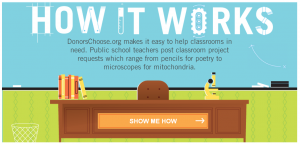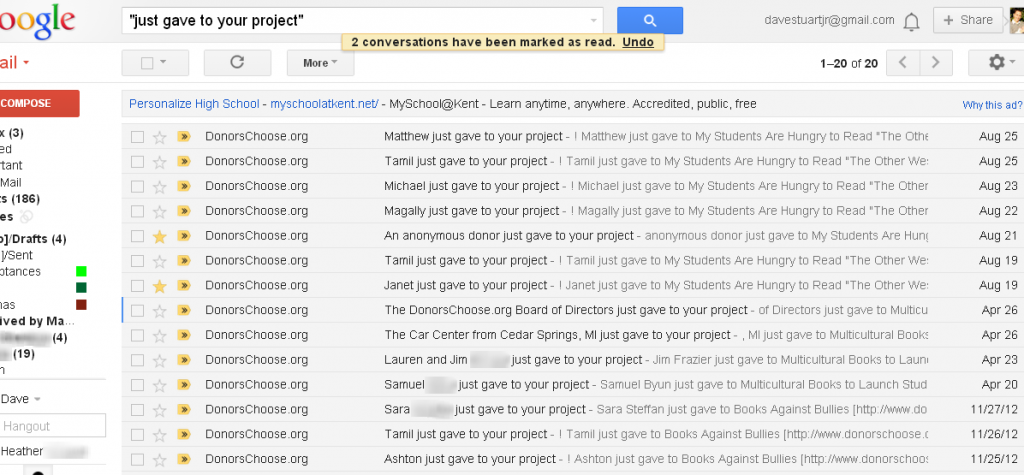So you're eager to challenge your students, Common Core style, with some challenging, complex texts. Or you're having students debate, but you'd like to get a Flip camera to record them for feedback. Or you'd like some paper. (I've taught in that school, too.)
The problem is schools have budgets, and, too often, they don't have space for your experimental curriculum that requires ninth graders to grit through All Quiet on the Western Front. “It's a nice idea, Mr. Smithensteinovich, but we're not willing to bet $400 that it will work.”
So what do you do?
If you're like most teachers, you go out to the store or you head to Amazon and you spend your own money.
But that's jacked up for a couple of reasons:
- For schooling to get better in the US, we've got to shift the responsibility from teachers alone to every last American. You taking on every classroom expense isn't achieving that end.
- There are plenty of citizen philanthropists who would love to help out with your classroom supply needs. Some of them you know right now. Some of them you'll never meet, but they'll still give hundreds of dollars of supplies to your students.
I'm not saying you don't need the supplies — you do. I needed classroom sets of All Quiet on the Western Front and Animal Farm and Bury My Heart at Wounded Knee and Escape from Camp 14 and Life of Pi and Things Fall Apart. Why? Because I need my freshmen students and everybody else in the world to know that “at-risk” students are usually just at risk of being coddled. I need to prove each year that teenagers will joyfully rise to ridiculously demanding expectations.
But beneath all that idealism is a very real price tag: a simple classroom set of the books listed above easily costs over $1,500.
$9,000 and counting
Here's the truth, good people: by using DonorsChoose.org over the past 6 years or so of my career, I have seen over $6,000 worth of specifically requested supplies magically enter my classroom, including a class set of every book listed above. This entire post is about how you, too, can realize your most audacious classroom supply needs, one DonorsChoose project at a time.
And this is somewhat of a mission-minded post, too, because one common question I hear when I speak to educators around the country is “How is Common Core implementation going to be funded?” My answer, first, is that it shouldn't be terribly pricey — so many shorter complex texts are free (like every one of the articles I use each week), and Common Core implementation doesn't require every kid to have an iPad or computer. And my second answer is for the few things that will cost money (i.e., a classroom set of longer texts — NOT a classroom set of “Common Core aligned” basals!), use DonorsChoose.
But the thing is, currently only about 50% of schools in America have a teacher who uses DonorsChoose to get their classroom supply needs met. I want that percentage to move up, and I want you to feel empowered to see your classroom supply needs met.
So I actually wrote an entire ebook on this post
As I was dreaming up this post, I ended up writing an entire ebook. The heart of that ebook is in this actual post — including every last strategy I use for dominating life on DonorsChoose — but there's a lot of extra material in the book including the benefits of using DonorsChoose, getting set up, an example of a failed project, some screencasts of me creating an actual DonorsChoose project, and other good stuff. Plus, the ebook is a bit handier as it's in a PDF format. To get free access to that ebook, just join the movement of teachers who refuse to freak out about the Common Core by subscribing to the email list below. (If you've subscribed before the site redesign, you did so through RSS and you'll need to re-subscribe to get this goodie. Thanks guys!)
[ois skin=”Ebook sign up — within post”]
Strategies for Getting Supply Requests Funded on DonorsChoose.org

These are the tactics I use to ensure my students get the resources I request on DonorsChoose. I have learned them over the years through experimentation, failure, and a boatload of generous donations.
1. THINK SMALL AND FOCUSED
To be a DonorsChoose Jedi who truly masters the forces of generosity at work online, you’ve got to remember this key principle: Rome wasn’t built in a day.
You may, like me, have an audacious vision that requires thousands of dollars in books or equipment, but you've got to break that up into smaller chunks.
Here's the thing: DonorsChoose projects that cost less than $400 are way more likely to get funded than those above $400. Similarly, those that cost less than $200 are way more likely still, and it's almost impossible not to get a $100 project funded.
So the idea is, especially if you’re new at DonorsChoose: think of your long-term vision for your classroom as a series of projects, not one mega project.
2. TAKE FULL ADVANTAGE OF FUNDING OPPORTUNITIES
Check out this link, which has been responsible for thousands of the dollars that have funded my students' dreams. On that page, pick your state and see what funding opportunities are currently available.
Whenever I go through this list, I first read to see which could possibly line up with supplies I need for my students. Then, if there’s anything that catches my eye, I’ll click on any links that give me more info (see red arrows in the image above), and I use that information when creating my project.
Tip: If you’re going for a funding opportunity, make sure you pay attention to details. I have had some that required certain text to be included in the project proposal and some that required key text to be in the title.
For example, in the Spring of 2013 I successfully received “Selective Funding from Chase” (see image above) for a project pertaining to multiculturalism. I knew that I wanted to add two more classroom sets of books to my world history class — Dee Brown’s Bury My Heart at Wounded Knee and Yann Martel’s Life of Pi. Now, the first thing that comes to your mind when you read these titles might not be multiculturalism, and, honestly, it’s not the first thing that comes to my mind, either.
However, upon thinking about it for a moment, I realized that these titles can help give students an appreciation for other cultures, and so I geared the entire project essay to that theme. As a result, the project was successfully funded (to have a look at my project essay, click here; notice how I used key words from the funding opportunity description throughout the essay).
Funding opportunities are crucial for lessening the amount of dollars you’ll need to raise from folks in your community. Use ‘em.
3. USE THE ‘FACEBOOK CONNECT' AUTOMATION TOOL
Facebook Connect is simply a tool that automatically posts to your timeline at key points in your project. For those of you wanting more specifics, the per project average is between 8 and 14 updates over the course of 4 months.
Every teacher I know who has tried this (including me) has been stunned at the distant acquaintances who will come out of the woodwork and give money to your project. It’s simply amazing.
Setting it up is simple:
Boom.
Now, whenever your project is live and seeking funding, DonorsChoose will keep your Facebook community respectfully informed.
Oh, and if you ever want to turn it off, it’s super easy — basically, follow the same steps you took to turn it on.
4. WHEN YOU GET TO $100 OR LESS ON YOUR PROJECT, SIMPLY WAIT

One of the magical things about DonorsChoose is that there are hundreds of people — normal folks like you and me — who have signed up to give X amount of dollars away to classrooms every month. And a lot of times, they love just randomly blessing a classroom through a project that catches their eye.
And so what they’ll often do is search for projects that are nearing completion (because who doesn’t love being the person who gives the last amount, right?) And DonorsChoose’s search algorithm tends to promote such almost-done projects.
So, starting a year or so ago, whenever my projects have come within $100 of funding, I have simply left them alone. Within days, I tend to receive an email saying I’ve received enough donations and the project is ready for fulfillment.
Try it out.
5. ALWAYS PRESENT OPPORTUNITY, NOT GUILT
I’ll end with this because, to me, it’s the key.
The last thing you want to do is have people associate your classroom with a guilt trip. No matter how bad off your school or your students or you are, I highly recommend framing every DonorsChoose project you create as an opportunity to join a classroom on a mission. At the end of the day, people want their lives to be a part of something greater — that’s what you’re providing with this opportunity to help fund your classroom vision.
Remember that. Believe that. It’s the truth.
Before you head out to get funding, do me a favor
Share this post with a like-minded colleague. Just write them a quick email, include the link, and boom — you've done me a solid.
Leave a Reply